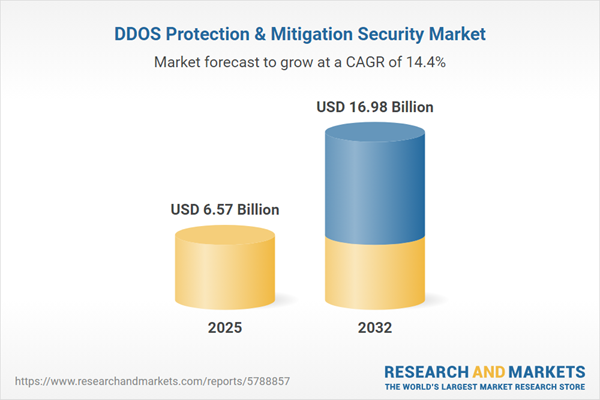Speak directly to the analyst to clarify any post sales queries you may have.
As digital transformation accelerates, organizations face increasing risks from sophisticated cyber threats. To maintain operational resilience and regulatory alignment, enterprises must deploy advanced DDoS protection and mitigation security strategies that address evolving threat landscapes and enable secure, uninterrupted business operations.
Market Snapshot: DDoS Protection & Mitigation Security Market
In 2023, the DDoS protection and mitigation security market stood at USD 5.78 billion, highlighting intensified investment in defending essential digital infrastructure. The market is expected to demonstrate a compound annual growth rate of 14.41%, rising toward USD 6.57 billion by 2025 and reaching USD 16.98 billion by 2032. This trajectory reflects accelerating adoption across industries determined to fortify their systems against increasingly complex attacks. Organizations are integrating adaptable security frameworks that combine real-time monitoring, rapid incident response, and layered defense tools. The market’s direction underscores the pressing need for comprehensive threat management strategies that meet regulatory obligations and foster technology adoption.
DDoS Protection & Mitigation Security: Scope & Segmentation
Leaders in IT, information security, and risk management require a thorough understanding of market segments and technology frameworks to align investments with both short-term needs and longer-term strategy. Solutions must be tailored to manage compliance, performance, and evolving global risks across an enterprise’s unique environment.
- Component: Managed security services deliver ongoing threat surveillance. Professional services simplify integration. Standalone deployments enable configuration for specialized defense needs.
- Deployment Mode: Cloud, hybrid, and on-premise models give organizations flexibility to meet regional data handling requirements and scale as operations grow.
- Type: Application-layer, protocol, and volumetric protection methods address different attack vectors. Organizations benefit from a multi-faceted approach to risk management.
- Industry Vertical: Solutions are adapted for sectors such as financial services, healthcare, government, defense, telecom, ecommerce, banking, and retail. This helps enterprises address strict compliance and sector-specific security demands while maintaining high performance.
- Organization Size: Platforms support small businesses and large enterprises alike, with scalable features that ensure seamless adoption and robust defense regardless of complexity.
- Region: The Americas, EMEA, and Asia-Pacific show unique adoption patterns shaped by local mandates, digitalization rates, and threat profiles. Regional differences guide procurement strategies and vendor selection.
- Key Vendors: Providers including Cloudflare, Akamai Technologies, F5, Radware, Cisco Systems, Fortinet, Juniper Networks, Netscout Systems, Imperva, and Corero Network Security deliver advanced capabilities and extensive industry experience.
DDoS Protection & Mitigation Security: Key Takeaways for Senior Decision-Makers
- Adopting cloud-first and hybrid deployments allows enterprises to support distributed workforces and ensure compliance with varying international mandates.
- Artificial intelligence and machine learning features in current platforms drive faster threat identification and response, streamlining security operations.
- Engaging managed service providers ensures 24/7 coverage, especially important for sectors facing strict compliance and specialized attack risks.
- Interoperability capabilities enable smooth integration with legacy infrastructure, supporting organizations that operate diverse or mature technology environments.
- Participating in global intelligence networks broadens attack visibility, equipping organizations to adjust to shifting threat vectors more effectively.
- Advanced analytics provide leadership with enhanced transparency, generating actionable insights for both compliance reporting and informed decision-making.
Tariff Impact on Supply Chains and Service Models
Anticipated U.S. tariffs scheduled for 2025 are driving providers to reconfigure supply chains and increase emphasis on managed, cloud-centric services. Many are forging regional partnerships to maintain compliance and operational resilience. These adjustments ensure continued service reliability and responsive support even as global economic and geopolitical factors evolve.
Methodology & Data Sources
The analysis draws on direct interviews with CISOs, insights from technical architects, and reviews of industry publications, alongside validated security incident data. This rigorous methodology yields practical intelligence that is sector-relevant and actionable.
Why This Report Matters
- Enables executives to synchronize DDoS mitigation strategies with enterprise goals and ongoing regulatory requirements.
- Delivers strategic perspective on evolving industry dynamics and compliance shifts, informing solution planning and investment priorities.
- Presents targeted, actionable recommendations for anticipating risks and strengthening organizational cyber resilience.
Conclusion
Aligning DDoS protection with enterprise strategy promotes business continuity and safeguards digital investments. Intelligence-led defenses position organizations to adapt confidently to emerging cyber threats while supporting growth and innovation.
Additional Product Information:
- Purchase of this report includes 1 year online access with quarterly updates.
- This report can be updated on request. Please contact our Customer Experience team using the Ask a Question widget on our website.
Table of Contents
3. Executive Summary
4. Market Overview
7. Cumulative Impact of Artificial Intelligence 2025
List of Figures
Companies Mentioned
The companies profiled in this DDOS Protection & Mitigation Security market report include:- Cloudflare, Inc.
- Akamai Technologies, Inc.
- F5, Inc.
- Radware Ltd.
- Cisco Systems, Inc.
- Fortinet, Inc.
- Juniper Networks, Inc.
- Netscout Systems, Inc.
- Imperva, Inc.
- Corero Network Security Ltd
Table Information
| Report Attribute | Details |
|---|---|
| No. of Pages | 191 |
| Published | November 2025 |
| Forecast Period | 2025 - 2032 |
| Estimated Market Value ( USD | $ 6.57 Billion |
| Forecasted Market Value ( USD | $ 16.98 Billion |
| Compound Annual Growth Rate | 14.4% |
| Regions Covered | Global |
| No. of Companies Mentioned | 11 |









